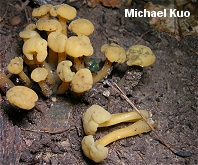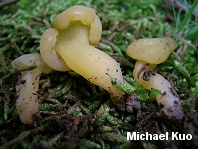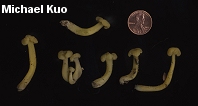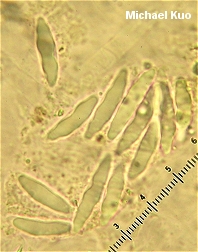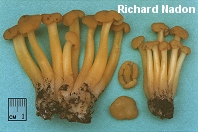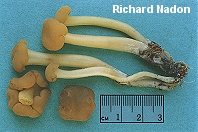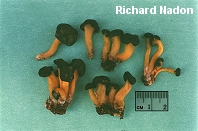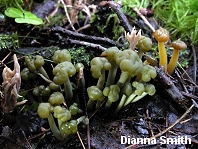| Major Groups > Oddballs & Misfits > Leotia lubrica |

|
Leotia lubrica [ Ascomycota > Leotiales > Leotiaceae > Leotia . . . ] by Michael Kuo These odd little mushrooms are sometimes called "jelly babies," and I keep waiting for Hollywood to make an animated children's feature by that name. The screenplay in my head calls for our hero, Jimmy Jelly, to overcome his humble background and become King of the Moss, casting out the evil Galerinas and making Mossland safe for everyone else. Soon we will see the marketing of Jelly Baby toys and video games, on a scale that puts the Smurfs and Power Rangers to shame. I am going to be rich, I tell you, rich beyond my dreams--and the fungal world will finally get the recognition it deserves! But first we will have to show the animators the distinctive features of a Jelly Baby, so they can develop accurate characters. Leotia lubrica is rather slimy--on the cap and stem--when fresh. It features a gelatinous, slightly wrinkled, vaguely convex cap, and a smooth stem. By traditional definitions, Leotia lubrica has a yellow or brownish yellow cap and a yellowish or yellow stem--while Leotia viscosa has a green cap and a yellow stem, and Leotia atrovirens has a green cap and stem (see illustrations to the right). However, the traditional definitions are pretty much wrong, according to more recent evidence from DNA studies:
According to Zhong & Pfister, thorough morphological, ecological, and biological studies will be required before species can be recognized accurately. And, I suspect, someone will need to provide a definitive answer to the suspicion held by several authors (e.g. Breitenbach & Kränzlin, 1984) that "Leotia atrovirens" may be merely a form of Leotia lubrica that has been attacked by a mold or an imperfect fungus, changing its colors in the process. Description: Ecology: Saprobic; growing gregariously under hardwoods or conifers (often in moss); occasionally found on rotting wood; late spring through fall (over winter in warm climates); widely distributed and common in North America. Cap: 1-4 cm; variable in shape but more or less convex; convoluted; bald; with a smooth or slightly wrinkled surface; sticky or slimy when fresh, but sometimes drying out; the margin inrolled; buff, brownish yellow, yellow, or olive--not infrequently turning dark green to nearly black with age; undersurface bald and pale. Stem: 2-8 cm long; up to 1 cm wide; bald; often adorned with tiny pale flakes; more or less equal; sticky or slimy when fresh; colored like the cap or paler; slowly bruising dark green where damaged; hollow or filled with gelatinous material. Flesh: Gelatinous when fresh. Odor: None. Microscopic Features: Spores 16-25 x 4-6 µ; narrowly ellipsoid to subfusiform; smooth; often curved; becoming septate, with 3-7 septa at maturity. Asci 8-spored. Paraphyses filiform; often forked; apices subclavate to irregularly swollen; 1-2 µ wide. REFERENCES: (Scopoli, 1772) Persoon, 1797. (Fries, 1822; Saccardo, 1889; Smith, 1949; Mains, 1956; Smith, Smith & Weber, 1981; Breitenbach & Kränzlin, 1984; Arora, 1986; Phillips, 1991/2005; Lincoff, 1992; Horn, Kay & Abel, 1993; Barron, 1999; Zhong & Pfister, 2004; McNeil, 2006; Miller & Miller, 2006.) Herb. Kuo 07180708, 07050803, 06260903. This site contains no information about the edibility or toxicity of mushrooms. |
© MushroomExpert.Com |
|
Cite this page as: Kuo, M. (2012, July). Leotia lubrica. Retrieved from the MushroomExpert.Com Web site: http://www.mushroomexpert.com/leotia_lubrica.html |
